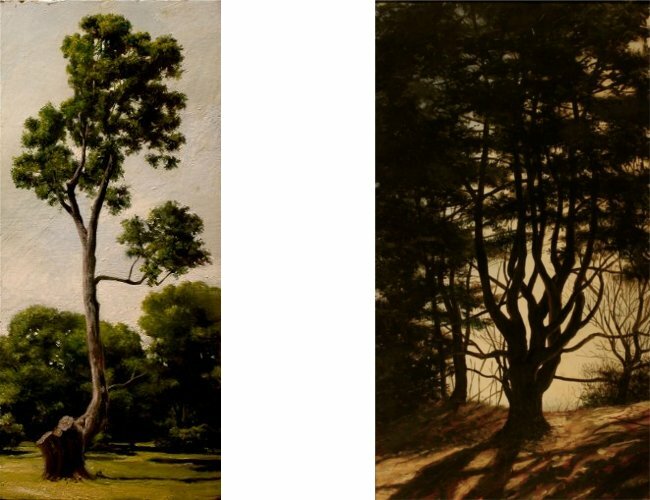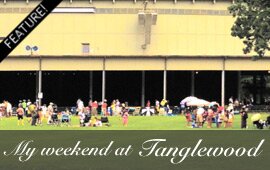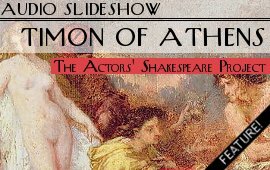
Along the streets of Boston this season, I haven’t seen so much as a precocious crocus to assure me this winter, too, shall pass. But at the , at least one variety of pussy willow (Salix gracilistyla) has already sprouted fuzzy catkins to shine in the winter sun. Just as encouragingly, the Arboretum’s Hunnewell Building Lecture Hall has an exhibition called which runs until March 6.
Apesos, a professor of painting and art history at the Art Institute of Boston at Lesley University, has at least two immediately apparent and laudable talents: the ability to create visual art that evokes a visceral reaction, and the ability to articulate essential aspects of the creative process for the edification of others. Because of the latter, former students who benefited from his tutelage years ago (including Ben Cohan, the artist/woodworker who framed the pieces in this exhibition) are eager to rave about the experience.
Landscapes aren’t what Apesos is best known for. He calls the human figure his “primary vehicle of expression” and his book on this subject, , is justly well-received. But living on the Arborway, he was eventually (and perhaps inevitably) drawn into the Arnold Arboretum’s particular spell and now includes it in his subject matter.
The end result is landscape paintings that don’t masquerade as idealized visions of untouched wilderness. His trees often show scars where arboricultural stewardship demanded the cutting away of damaged branches. His bucolic scenes are sometimes transected by the manmade paths where Arboretum visitors stroll. Even when it’s not obvious, these are still human-made scenes with woody species that are co-endemic nowhere in nature.
Apesos embraces these elements to make human experience the emotional core of these landscapes, even when no human figure is depicted. Wordlessly, yet with an eloquent candor, we’re told that the artist was neither the first nor the last to lovingly appreciate the scenes depicted. They’re no ones personal secret discovery; these are the beautiful or interesting Arnold Arboretum scenes we’ve been emoting about for generations. Each painting is anchored to a specific site and simple titles such as “Towards Center Street Gate” hint at this.
At least as importantly, his painted trees are as exactly rooted in time as they are in space. During the creative process, Apesos paints from photos as well as sketches. Return to one of these spots thirty minutes later, and the movement of light would have changed its character. Return a year later, and the adding and subtracting of specific branches or herbaceous undergrowth will have certainly marked time’s passing. Our collective experience of these landscapes informs the palpably specific experience of the artist, but the two aren’t confused.

Last Summer & Light Through Pine, Anthony Apesos
As for that light, Apesos uses it to startle and excite our perceptions. In many of these landscapes, it’s the light of the summer sun for sure–a fearless light that cuts like a hot blade through leafy canopies and seems ready to incinerate the unsheltered. By igniting what it illuminates, it plunges other areas into near-darkness by comparison. While effective management of these contrasts can be a photographer’s nightmare, Apesos’ deft painterly treatment of them is, in this observer’s eye, the most interesting and emotion-provoking aspect of his landscape work.
Like many successful artists, Apesos is firstly an observer. He says “I care about the time of day, the kind of weather, the geology, and the plant life that I depict. For me a landscape painting is not merely a record of a visual impression, but is a response to what is really there.”
A keen interest in what he calls “botanical specificity” led Apesos to create a herbarium of preserved plant specimens to share and discuss with his daughter. When he expresses it on canvas, this same attention to plant morphology gives savvy viewers the opportunity not only to identify specific varieties depicted, but specific specimens with which they’re familiar. “It pleases me when people try to identify the plants in my paintings,” he says. These plant specimens might originate from all corners of the world, but now they share a space in Boston. “For me,” says Apesos, “the sense of space is essential.”
“I appreciate the Arboretum for its sense of variety,” he describes, “not only the range that is here, but how it represents the range of nature in general. Many of the artists whom I admire the most seem to have a desire to embody the macrocosm within their work. This ambition has led me to paint the variety that we see in the Arboretum because that variety there, through the work over generations of its landscape designers and arborists, has as various a landscape within the smallest perimeter one can imagine at our latitude.”

Anthony Apesos at the Arnold Arboretum (Dwyer)
Blake’s interest in the mystical worlds of consciousness seems to resonate in Apesos’ reflections on art. According to Apesos, “Paintings exist to create new spaces for the viewer’s imagination to enter. The miracle of painting that it is both a flat surface and a three-dimensional illusion at the same time. It is this paradoxical quality, this simultaneity of opposites, that makes painting miraculous and justifies its existence.”
Although Anthony Apesos has been painting the Arboretum since he moved to Jamaica Plain in the early 1990s, all the summery paintings currently on display were produced by his quick hands in just the last two years. Another exhibition of his Arboretum work–this time focusing on winter scenes–is in the planning stage but no dates have been set.
Thursday, February 25, from 6:30pm–8:00pm, Apesos will be at the Arboretum to talk about his work. Seize the opportunity if you’re in this neck of the woods.





I brought three people to Anthony’s show at the Arboretum on opening day. We all loved it. Anthony Apesos is a brilliant lecturer as well a master painter. He recently took a group of us students to the MFA’s Titian, Tintoretto and Veronese exhibit. He humbly held forth about the history, art history, aesthetics and mythological underpinnings of these painters’ works for over an hour. It was spellbinding. I urge everyone to attend his arboretum lecture on February 25th. John, you’ve written a passionate, yet analytical critique of his work. Kudos.
Check out Roberto Mighty’s website by clicking his name above. He’s a multitalented man!